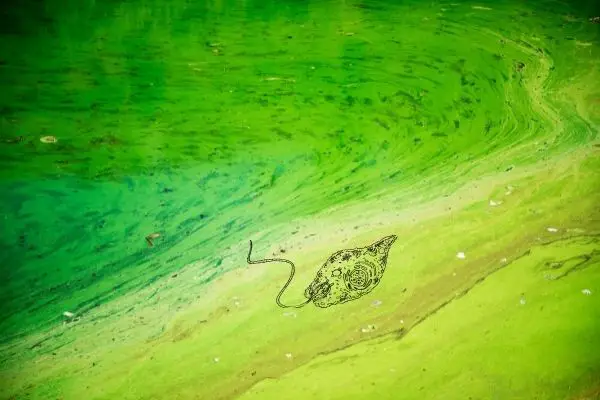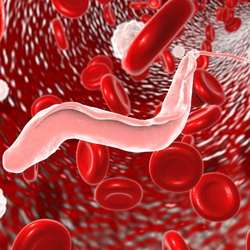Euglena is a group of microorganisms that are not quite animals nor plants, but protists. The difficult classification stems from their ability to obtain energy from the sun as well as organic matter.
Euglena can be harmful to both humans and animals, depending on the species. Euglena species are involved in forming toxic algae blooms in freshwater lakes and ponds, which can be harmful to fish populations, and potentially harmful to humans.
Euglena also includes pathogenic species that are extremely harmful to humans through parasitic diseases.
Finally, some euglena have some actual and potential health benefits to humans!
Can Euglena be Toxic to Humans or Animals?
Several species, including E. sanguinea and E. viridis, can produce large toxic populations of red or green algae, known as ‘blooms,’ in freshwater ponds or lakes with high nitrogen content.
E. sanguinea produces a toxin, called euglenophycin, which is an alkaloid similar in structure to fire ant venom, solenopsin.
Euglenophycin is a neurotoxin, causing fish exposed to the algae to show symptoms of disorientation, increased respiration, inability to maintain balance, and reddened gill tissue.
As euglenophycin as only identified in 2002, scientists still don’t fully understand its mechanism of action.
More recent studies have identified six additional species that produce the same toxin, however E. sanguinea forms much denser toxic blooms, and is the only known species of euglenid that can have significant impact on fish populations.

There is some research indicates that toxic euglenophycin algal blooms can pose an acute risk to human health, although further testing is necessary to understand at what level of exposure or toxicity that it becomes harmful.
What Pathogenic Species Belong to Euglena?
All members of Class Euglenozoa that are pathogenic in humans fall into one class: Class Trypanisomatida, which contains two infectious genera: Leishmania and Trypanosoma.
Trypanosomes are parasitic zooflagellate protozoans, which are mainly blood parasites of vertebrates, particularly fish, birds, and mammals.
Most species need an intermediate host, like an insect, to complete the life cycle. Trypanosomes are a genus of parasites responsible for a variety of disease, including: Human African trypanosomiasis, leishmaniasis, and Chagas’ disease.

Leishmania are a genus of tryposomes that are responsible for the disease leishmaniasis. It is spread by sandflies, Phlebotomus in the Old World and Lutzomyia in the New World. Their primary hosts are vertebrates.
What Diseases can Euglena Cause?
Euglena as a larger group of organisms to which the Trypanosoma subgroup belongs. Trypanosoma are motile parasites that are known as causative agents of several human and animal diseases.
1. Sleeping Sickness
Human African trypanosomiasis, or African sleeping sickness, is a parasitic disease transmitted by tsetse flies infected with protozoan parasites belonging to the Trypanosoma.
Without treatment, this disease is fatal. There are two forms of the disease, depending on the sub-species of parasite involved:
Trypanosoma brucei gambiense accounts for 95% of reported cases and causes a chronic infection. People can be infected for months or years without symptoms.
Once symptoms emerge, the disease has usually already begun to affect the central nervous system. This form is found in western and central Africa.
Trypanosoma brucei rhodesiense represents less than 5% of reported cases and causes an acute infection. This form is found in eastern and southern Africa.
The only place where both forms of Human African trypanosomiasis can be found in Uganda, but in separate regions.
The first stage of infection can involve fever, malaise, severe headaches, irritability, extreme fatigue, swollen lymph nodes, aching muscles and joints are common symptoms.
Once the disease has reached the central nervous system in the second stage, the patient can experience confusion, personality changes, and other neurologic impairments.
2. Chagas’ disease
Chagas’ disease, also known as American trypanosomiasis, is caused by the euglenoid protozoan parasite, Trypanosoma cruzi.
The disease is primarily transmitted to humans through contact with feces or urine of triatomine bugs, which can carry T. cruzi.
Around 6-7 million people worldwide, primarily in Latin America, are infected with the Euglena parasite which causes Chagas’ disease.
Chagas’ disease has a different range, vector, parasite, and different disease characteristics from the two forms of Human African trypanosomiasis.
3. Leishmaniasis
Leishmaniasis is a parasitic disease caused by infection with Leishmania parasites, which are spread by the bite of phlebotomine sand flies. This disease is found primarily in parts of the tropics, subtropics, and southern Europe.
Leishmaniasis has four forms: cutaneous leishmaniasis (CL), mucocutaneous leishmaniasis (MCL), visceral leishmaniasis (VL), and post-kala azar dermal leishmaniasis (PKDL). The most common are cutaneous leishmaniasis and visceral leishmaniasis.
Cutaneous leishmaniasis causes skin sores. Kala-azar, or visceral leishmaniasis, is the second largest parasitic killer in the world and a form of leishmaniasis.
The disease attacks the immune system, affecting the spleen, liver, and bone marrow, and is fatal is not treated.
There are approximately 200,000-400,000 new cases a year, primarily in India, Bangladesh, Nepal, Sudan, and Brazil.
All of these parasitic diseases are classified as neglected tropical diseases (NTD), which the CDC defines as “a group of preventable and treatable parasitic, viral, and bacterial disease that affect more than one billion people globally”.
Can Euglena be Beneficial to Human Health?
Yes! At least some species of Euglena can.
People may be familiar with euglena recently due to its emergence as a ‘superfood’. Euglena is a nutrient rich algae that is being sold in powdered form. It is mineral and vitamin-rich, containing 59 essential nutrients.
It looks like green tea powder and tastes like dried sardine flakes. It is being used as an ingredient in hair and scalp products, feed livestock and aquaculture, cosmetic and beauty products, in drinks, and in food products.
Large fast-food companies have even started incorporating it as an ingredient in their foods. The Denny’s restaurant chain introduced a hamburger steak platter containing 0.3 grams of euglena powder.

Recent research has shown that euglenophycin may have some potential as an anti-cancer agent. The toxin has been shown to inhibit tissue cell growth in mammalian cancerous lines under laboratory conditions.
The toxin disrupts a number of cellular functions related to cancer growth, including the mTOR pathway, which is important for stimulating cancer cells; inhibits VEGF, which blocks oxygen and nutrients from growing tumors; and also inhibits the Pi3K protein, which has a number of downstream effects.
Astaxanthin is a keto-carotenoid, produced naturally in freshwater microalgae like euglena and blepharisma protists, and gives a bright-red pigment.
Carotenoids are a class of pigments that are created by plants, algae, and photosynthetic bacteria.
Carotenoids are the reason for some plants and algae having bright yellow, orange, and red colors. Astaxanthin is also used as a dietary supplement since it is an antioxidant. It is the same type of compounds that give flamingos their pink color!
Astaxanthin is used for athletic endurance, healthier skin, muscle soreness, heart health, and joint pain. However, there is no scientific evidence supporting the supplementation of astaxanthin for these uses.
References
https://www.ncbi.nlm.nih.gov/pmc/articles/PMC5380236/
https://link.springer.com/article/10.1007/s10811-017-1376-z
https://www.sciencedirect.com/topics/agricultural-and-biological-sciences/euglenozoa
https://www.doctorswithoutborders.org/what-we-do/medical-issues/kala-azar
https://www.cdc.gov/globalhealth/ntd/
https://www.cdc.gov/parasites/leishmaniasis/gen_info/faqs.html
https://www.who.int/news-room/fact-sheets/detail/trypanosomiasis-human-african-(sleeping-sickness)




